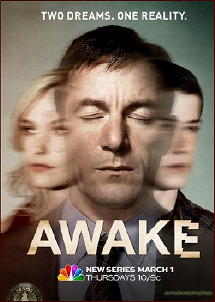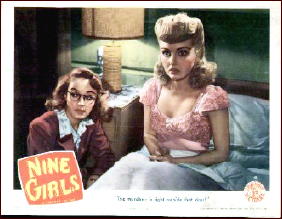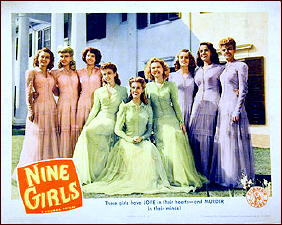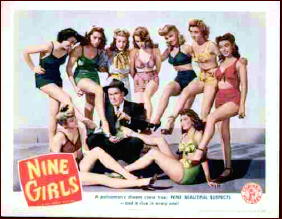Search Results for 'jas'
Did you find what you wanted ?
Fri 27 Apr 2012
REVIEWED BY GEOFF BRADLEY:
DIAMOND GEEZER. Granada TV, UK, April 2007. David Jason, Stephen Wight, Gary Whelan. Created by Caleb Ranson.
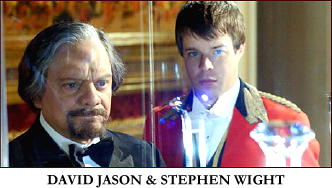
Diamond Geezer was a three part series (90 minutes each, less adverts) to follow up the original programme (20 March 2005). Des (David Jason) is a superior crook with a heart who sets out to accomplish some impossible crimes. They are watchable but ludicrous and certainly not as clever as they profess to be.
For example in the first, where Des steals the world’s largest diamond from Buckingham Palace no less, he has an accomplice press a button on a phone-sized devise which immediately knocks out all the close circuit TV in the Palace. No explanation at all as to what this devise is that can render the security useless or how Des could get one.
Amusing, I suppose, if you want an evening with the brain disengaged.
Editorial Comment: Although not released in the US, all three episodes plus the 2005 pilot are available on DVD in the UK. You need a multi-region player, but the box set should not cost you more than $20, including shipping. I had thought of picking it up, but after reading Geoff’s review, I am much less anxious to do so.
Sun 25 Mar 2012
A TV Series Review by Michael Shonk
BLUE LIGHT. ABC, 1966. Rogo Production in association with 20th Century Fox Television. Cast: Robert Goulet as David March. Christine Carère as Suzanne Duchard. Created by Walter Grauman and Larry Cohen. Executive Producer: Walter Grauman. Executive Script Consultant: Larry Cohen. Producer: Buck Houghton. Theme: Lalo Schifrin. Music Supervision: Lionel Newman.
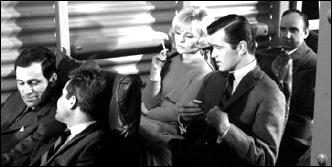
Blue Light is a forgotten TV spy series that, while not the equal, is worthy of mention with other TV spy series such as I Spy and Mission: Impossible.
Before the Nazis began their advance across Europe, America put eighteen sleeper agents inside Germany. One was American journalist David March. Only the few American government officials behind the Blue Light organization knew the truth, while the rest of the world believed March had betrayed his country and all he loved to join the Nazi war effort. In one episode March learned the woman he loved had committed suicide because of his support of the Nazi cause.
Occasionally the Nazis used March as a spy, but his usual role was writing and broadcasting propaganda. His underground contact was Suzanne, who fell in love with March as she posed as French Gestapo agent who hated him.
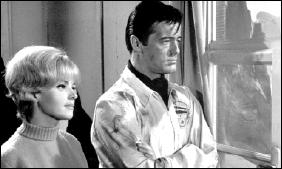
Considering the creative talent behind Blue Light, it is not a surprise the series was a gritty WWII spy drama with nourish touches. Larry Cohen is best known for his genre films such as Black Caesar, It’s Alive, and Maniac Cop. He also created the TV series Branded, Coronet Blue and The Invaders.
Walter Grauman is one of television’s iconic directors (Untouchables to Murder, She Wrote). He also won the Distinguished Flying Cross for his service as a fighter pilot in WWII Europe. There is an excellent interview of Walter Grauman by Stephen Bowie at the Archive of American Television. (Follow the link.)
The series did not pull any punches. Episodes featured dramatic examinations of moral issues as well as surprising twists and great action. March did not just knock out the guard as most TV good guys would. Instead, March did not hesitate to kill the guard with a knife in the back.
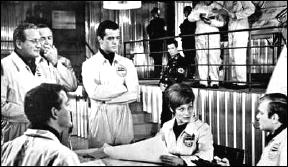
There were few easy solutions to the many choices March was forced to make. In one episode he was forced to choose between some citizens who had escaped a Nazi labor camp or getting a top secret Nazi weapon to the Allies in England.
Known more as a singer, Robert Goulet was surprisingly believable as David March, double agent. On the other hand co-star Christine Carère proved to be a liability to the series and weaken the possible romantic subplot. The guest stars included some of the best TV characters actors of the 60s, especially European actors on their way to America. (See the episode index below.)
The production was shot overseas at Bavarian Studios in Munich, Germany. According to an interview of Robert Goulart in Stars & Stripes (2/16/66), Blue Light was the first American TV series filmed in color in Europe.
The music soundtrack by Lalo Schifrin and others (including Pete Rugalo, Mullendore and David Gruson) was a special delight. Listen to episodes such as “Sacrifice!†and “Agent of the East†and you can hear occasional hints of Schifrin’s future work in Mannix and Mission: Impossible.
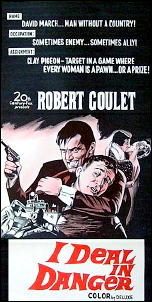
Blue Light had the potential to be something special, but it was limited by its half hour format. While the short time kept the action moving, it eliminated the opportunity to further develop the characters. The villains were often underdeveloped and weakened by the speed March outsmarted them.
It is best to watch the episodes in order. The first four episodes told the story of David March’s mission to destroy a top secret Nazi weapon base in Grossmuchen, Germany. “Return of Elm†and “The Secret War†are based on events in earlier episodes.
The first four episodes were linked together and released as I Deal in Danger (1966). I have not seen the movie version, but it is available on DVD. The series itself is available only in the collector-to-collector market.
EPISODE INDEX —
“The Last Man” (1/12/66). Written by Larry Cohen. Directed by Walter Grauman. Guest Cast: Werner Peters, John Ragin, John Alderson. â— The Nazis know about Blue Light, an American undercover spy ring of eighteen agents. Seventeen have been killed. Now, Captain Elm is out to get rid of the man he believes to be the last man of Blue Light, American journalist now Nazi propagandist David March.
“Target David March” (1/19/66). Written by Larry Cohen. Directed by Walter Grauman. Guest Cast: Edward Binns, Hans Reiser, Geoffrey Frederick. â— With Elm gone, March still needs to convince some Nazis he is loyal to the cause before he can be assigned to the top-secret weapon base in Grossmuchen. Meanwhile a British officer has sent in three commandos to kill the American traitor David March.
“The Fortress Below” (1/26/66). Written by Larry Cohen. Directed by Walter Grauman. Guest Cast: Eva Pflug, John van Dreelan, Peter Capell, Manfred Andrae. â— March gets the assignment he wanted, the top-secret weapon base. The base is buried 200 feet underground and while nearly impossible to sneak in, it is even harder to get out. Unable to sneak any weapons in, March must figure out how to destroy the base.
“The Weapons Within” (2/2/66). Written by Larry Cohen. Directed by Walter Grauman. Guest Cast: Eva Pflug, Horst Frank, Alexander Allerson, Dieter Eppler. â— The naïve female German scientist who had agreed to help March’s blow up the base has second thoughts when she is faced with causing the death of her friends at the base.
“Traitor’s Blood” (2/9/66). Written by Larry Cohen. Directed by Walter Grauman. Guest Cast: Jerry Ayres, Henry Beckman, David Macklin. â— March visits his younger brother being held in a Nazi POW camp. His brother had lied about his age to join the Army and prove he was not a traitor like his brother.
“Agent of the East” (2/16/66). Teleplay by Donald S. Sanford, story by Larry Cohen. Directed by James Goldstone. Guest Cast: Jan Malmsjo, Dick Davalos, James Mitchell. â— To keep the plans for a heavy water plant from Nazi scientists, March must get to a captured Russian spy being held in Gestapo headquarters.
“Sacrifice” (2/23/66). Teleplay by Dick Carr, story by Larry Cohen. Directed by William Graham. Guest Cast: Larry Pennell, Barry Ford, James Brolin. â— The Nazis want March to convince a kidnapped All American hero to talk. An Allied bomb hits the Gestapo jail trapping March, the hero and two Nazis underground with no hope of rescue.
“The Secret War” (3/2/66). Written by Larry Cohen. Directed by Walter Grauman. Guest Cast: Roger C. Carmel, Kevin Hagen, Gail Kobe, Fred Holliday, Gilbert Green. â— Two Russian agents, who knew the Russian agent from “Agent of the East,†threaten to expose March and Suzanne if he does not work for them instead of the Americans.
“Invasion by the Stars” (3/9/66). Teleplay by Jack Turley, story by Curtis Sanders. Directed by Gerd Oswald. Guest Cast: Francis Lederer, Curt Lowens, Jason Wingreen. â— Allies need Operation Sea Lion, Hitler’s planned invasion of England, delayed. March attempts to convince Hitler’s astrologist to advise Hitler to postpone the invasion.
“The Return of Elm” (3/23/66). Written by Larry Cohen. Directed by Robert Butler. Guest Cast: Werner Peters, Malachi Throne. â— Elm, the villain of “The Last Man†episode, is back. The one Nazi who knows March is an American agent, Elm escapes a British POW camp. Knowing the Nazis believe he is the traitor, Elm returns to Berlin to kill March and clear his name.
“Jet Trail” (4/6/66). Written by Dan Ullman. Directed by James Goldstone. Guest Cast: Philippe Nicaud. Tony LoBianco, Lamont Johnson. â— March poses as an American OSS officer to help the French resistance recover a top secret German jet engine from a crash.
“How to Kill a Toy Soldier” (4/13/66). Written by Merwin Bloch and Roger E. Swaybill. Directed by Leo Penn. Guest Cast: Michael Shea, Donald Losby, Greg Mullavey. â— An 11-year-old Nazi witnesses March kill a courier for the plans to every rocket site in Norway. March faces the choice of killing the child or exposing himself as a spy.
“The Deserters” (4/20/66). Writer: Curtis Sanders. Director: Gerd Oswald. Guest Cast: Ken Lynch, Stuart Margolin, George Backman, James Davidson. â— The Germans send March into battle posing as an American soldier. He is to learn what direction the Allied forces will take on the Italian front. A Gestapo agent travels with March to watch him.
“The Other Führer” (4/27/66). Written by Walter Brough. Directed by James Goldstone. Guest Cast: David Sheiner, Paul Carr, Jack Colvin. â— A German aristocrat seeks the Allies aid to overthrow Hitler. The Germans catch and execute the Allies’ agent sent to meet the aristocrat and send March in the Allies agent’s place.
“The Key to the Code” (5/4/66). Written by Brad Radnitz. Directed by Walter Grauman. Guest Cast: Hans Gudegast (Eric Braeden), Alex D’Arcy, Erik Holland. â— While in France to do a radio program, March and Suzanne learn the Germans have set a trap for an upcoming Allies Commando attack. The Germans have broken the underground code putting March and Suzanne at risk and unable to warn the Allies about the trap.
“Field of Dishonor” (5/11/66). Written by Jamie Farr and H. Bud Otto. Directed by James Goldstone. Guest Cast: Steve Ihnat, James Frawley. â— High-ranking Nazi General, who has long been suspicious of March’s loyalties, attempts to defect to the Allies.
“The Friendly Enemy” (5/18/66). Written by Harold Livingston. Directed by James Goldstone. Guest Cast: Mark Richman, Robert Doyle, Richard Carlyle, James Doohan, Mort Mills. â— March is ordered to kill a German scientist who is close to creating an Atomic bomb for the Nazis.
Sat 25 Feb 2012
A TV Review by Michael Shonk
AWAKE. NBC. 20th Century Fox Television. “Pilot.†01 March 2012, Thursday at 10pm (Eastern). Cast: Jason Isaacs as Detective Michael Britten, Laura Allen as Hannah, Dylan Minnette as Rex, Steve Harris as Det. Freeman, Wilmer Valderrama as Det. Vega, Cherry Jones as Dr. Evans, B.D. Wong as Dr. John Lee, Michaela McManus as Tara. Written and created by Kyle Killen. Directed By David Slade. Free sneak preview available at NBC.com, Hulu.com, iTunes, Amazon Instant Video, and other streaming and downloading services.
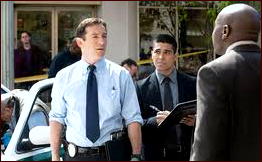
Detective Michael Britten (Jason Isaacs, Case Histories) was driving one night, his wife and son with him in the car. For reasons unknown the car goes off a cliff and crashes. Now Michael has two lives, one where his wife is alive and his son is dead, and the other where his son is alive and his wife is dead.
We see him with his wife Hannah (Laura Allen, Terriers) who is trying hard to accept and move on from the death of their son. At work, his partner Det. Freeman (Steve Harris, The Practice) is reassigned and Det. Vega (Wilmer Valderrama, That 70’s Show) is made his new partner. His superiors force Michael to see therapist Dr Lee (B.D. Wong, Law & Order: SVU). His new case has him trying to catch a serial killer who poses for security cameras. Back home he falls asleep next to his wife.
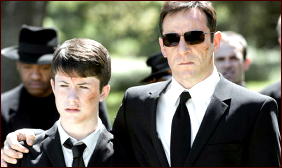
He wakes alone. He walks down the hallway of his home and greets his very alive son. In this life, his wife is dead. Freeman continues to work with him and Vega remains a patrolman. His superiors force him to see therapist Dr. Evans (Cherry Jones, 24). The case here is a kidnapped child.
The characters in the two worlds seem to be opposites: the wife versus the son, the inexperienced new partner versus the experienced partner, the gruff male shrink versus the sweet female shrink.
Unexplainably, the crimes connect as Michael finds clues in one life that leads to the solution of the crime in his other life.
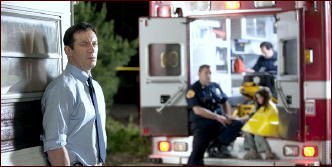
Each therapist tries to convince him that his or her world is the real one and that he needs to accept the death of the loved one in his “dream†world.
Those who enjoy procedural TV drama should enjoy the double dose every week. Those who enjoy series with deeper mysteries running through the background will find much to speculate about.
Why did he crash? Why did they find alcohol in his bloodstream after the crash when he hadn’t had a drink that night? Which life is real? Does either world exist beyond Michael?
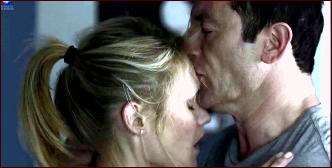
Why did both of his partners have life changing events happen to them, yet see those events as they related to Michael? When Michael woke and could not find his wife or son, why did he freak out?
Can Michael survive living two lives? Given a chance to live life with his wife and his son, Michael sees no reason to accept the death of either. Except his wife and son can’t move on and start a new life without Michael losing one of them.
Time will tell how long show creator Kyle Killen (Lone Star) and the writers can keep this premise interesting, but this episode is worth watching.
Tue 7 Feb 2012
REVIEWED BY WALTER ALBERT:
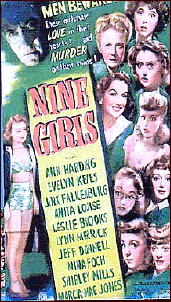
NINE GIRLS. Columbia, 1944. Ann Harding, Evelyn Keyes, Jinx Falkenburg, Anita Louise, Leslie Brooks, Jeff Donnell, Nina Foch, Lynn Merrick, Shirley Mills, Marcia Mae Jones, Williard Robertston, William Demarest, Lester Matthews, Grady Sutton. Director: Leigh Jason. Shown at Cinecon 39, Hollywood CA, Aug-Sept 2003.
This was the third of the Leigh Jason films that have become an eagerly awaited event at Cinecon. (The earlier films were Dangerous Blondes and Three Girls About Town.)
A bevy of sorority sisters, chaperoned by Ann Harding (recovered from her tragic demise in East Lynne), drives to a mountain lodge where almost immediately Anita Louise, the most unpleasant member of the group, is murdered. Nina Foch and Evelyn Keyes are the prime suspects as the cops arrive and the entire crew is prevented from leaving by a convenient storm.
The humor is somewhat broader (and less effective) than in the other two films, but this was still a delightful film. The screenwriters (Karen DeWolf and Connie Lee) also wrote for the Blondie series, one of my early affections (or rather, Penny Singleton was the affection).
Editorial Comments: My own review of this film appeared earlier on this blog. Check it out here. Of the three lobby cards shown below, only the first two are (as I recall) from the movie itself. I have a feeling that the one at the bottom (with the girls in bathing suits) is only a promotional pose.
Mon 30 Jan 2012
A TV Series Review by Michael Shonk
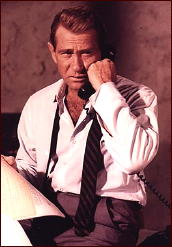
THE OUTSIDER. NBC. 1968-1969. 26 episodes at 60 min each. Universal and Public Arts (* Executive Producer Roy Huggins). Cast: Darren McGavin as David Ross. Theme by Pete Rugalo. Created by John Thomas James (Roy Huggins). Produced by Gene Levitt. (*) Huggins had nothing to do with the series but owned Public Arts so his credit was with the Public Arts Production screen credit. Previously on this blog: A review of the TV Movie pilot The Outsider.
The Outsider tried hard to be loyal to its noir roots but it was born at the wrong time. From Broadcasting (8-19-68) article entitled “1968-69: The Non Violent Seasonâ€:
“Actually no show has had a rougher time of it in the anti-violence climate than the Universal Television–Public Arts Production of The Outsider. It was bought by the network and in production long before the [Bobby] Kennedy assassination.â€
It was August (first episode aired September 18th) and fifteen episodes had been completed, but NBC was still demanding changes. Series producer Gene Levitt commented that they were still redubbing the first eight episodes and had been doing so every day for the last seven weeks.
The article sites an example of the changes. In episode “Love Is Under L,†the original finished scene had the bad guy attack Ross with a knife. Ross flips the guy over a bar counter. The guy rises from behind the bar ready to continue the fight when he realizes his knife is in his chest. He pulls out the knife and dies. The edited scene that made it to the air has the man never rising from behind the bar and Ross’ reaction telling the audience the bad guy was dead.
The first episode was a hit in New York easily winning its Wednesday 10pm time slot with a 43 share. But the reaction was best summed up by Chicago Daily News Dean Gysel, “It is one thing to avoid violence … another to avoid drama.†(Broadcasting, 9/23/68)
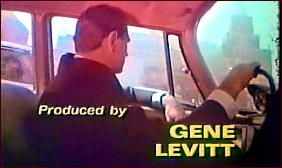
While not as well remembered as Roy Huggins, showrunner Gene Levitt also had a long successful career. In 1947 he adapted Raymond Chandler’s stories for the radio series Philip Marlowe starring Gerald Mohr. Most famous for creating Fantasy Island, Levitt’s credits include such shows as Front Page Detective, Maverick, Combat, Alias Smith & Jones, Barnaby Jones, and Hawaii Five-O.
I have recently watched the following episodes:
“One Long-Stemmed American Beauty.†Written by Shirl Hendryx. Directed by Alexander Singer.
Noir tale of life in Hollywood as Ross investigates the death of a former dancer turned bit part player and gigolo. Guest Cast: Judith McConnell as Dorothy, Marie Windsor as Leslie.
“I Can’t Hear You Scream.†Written by Edward J. Lakso. Directed by Alexander Singer.
Noir with a heavy mix of 60’s social injustice has Ross on his own trying to save a black small time criminal from execution. The black cop does not think the criminal is worth saving, the thief’s mother does not trust Ross because he is white, the childhood sweetheart refuses to help, and the current girlfriend is more worried about her Hollywood career. Guest Cast: James Edward as Lt. Wagner, Ena Hartman as Eleanor.
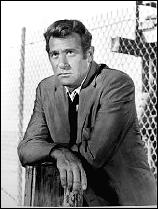
“Tell It Like It Was…And You’re Dead.†Written by Bernard C. Schoefeld. Directed by Alexander Singer.
A lonely forgotten star of burlesque decides to write her memoir. When someone tries to kill her, she hires Ross to find out who wants her silenced. Ross falls deeply in love with the memoir’s ghostwriter (who survives and apparently never mentioned again). Noirish soap opera. Guest Cast: Whitney Blake as Judy, Jackie Coogan as Rusty.
“The Girl From Missouri.†Written by Edward J. Lakso. Directed by Richard Benedict.
Naïve girl is looking for her brother in the evil big city L.A. She plans to reunite him with their dying father back in Missouri. Less noir and more like a Mannix episode. Guest Cast: Mariette Hartley as Mary, Jaye P. Morgan as Ginny.
“A Bowl of Cherries.†Written by Bob and Esther Mitchell. Directed by Michael Caffey.
A friend from prison asks Ross to check on his son. The young hotheaded Latino has fallen in love with his white boss’ son girlfriend. Pure 60’s social injustice plot with noir ending illustrating how close 50’s noir and 60’s social injustice stories were in theme. Guest Cast: John Marley as Jason, Tom Skerritt as Arnie.
“Through a Stained Glass Window.†Written by Ben Masselink. Directed by Charles S. Dubin.
The next to last episode of the series was a comedy. The thief who stole and hid $250,000 is finally out of prison. Ross is hired by the victim to follow the thief and get his money back. Ross is not alone as others have the same idea. On the way Ross encounters a series of eccentric characters right out of an episode of The Avengers. Guest Cast: Ruth McDevitt as Alice, Walter Burke as Fox.
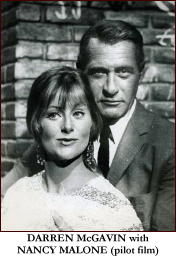
“48-Hr. Mile.†TV movie featuring episodes: “Flipside†and “Service For One.†Produced by Harry Tatelman and Gene Levitt. Written by Rita Lakin & Rick Edelstein and Don Carpenter. Directed by Gene Levitt.
“Flipsideâ€: Janet, a shy prudish woman wants Ross to find and stop her out of control sister Diane. Average psychological drama with a better than average cast. Guest Cast: Carrie Snodgrass as Janet, Michael Strong as Dr. Gaynor.
“Service For Oneâ€: Ross is hired to serve a subpoena to reclusive billionaire Bernard Christie. Ross encounters a woman who has fallen in love with Christie’s alter-ego Harry, and a writer who was ruined by the ruthless rich man. Nice noir ending. Guest Cast: William Windom as Christie, Kathie Browne as Amy.
The two episodes are clumsily linked with added storyline of Ross thinking Diane was another girlfriend of Christie.
“Anatomy of a Crime.†TV Movie featuring episodes “Tell It Like It Was…And You’re Deadâ€(see above) and “There Was A Little Girl.†Written by Bernard C. Schoenfeld and Kay Lenard & Jess Carneol. Directed by Alexander Singer and John Peyser.
“There was a Little Girlâ€: A woman claims her step-daughter is really a rich man’s daughter who was kidnapped 12 years ago and never found. Guest Cast: Joan Blondell as Sadie, Simon Scott as Harrington.
The two episodes were awkwardly joined by a voice over (Ross) explaining the two different clients hired Ross on the same day.
From the episodes I have seen, it is apparent the writers were still exploring who David Ross was. Should he fall in love every week or be a detached professional? Is he an outsider with no friends and live in a dump of an apartment or does he have old friends, wear suit and tie, and live in a typical PI office (no secretary)?
McGavin had his limitations. While he made loser Ross admirable, McGavin was unbelievable as Ross the ladies man.
Levitt and the writers would have fixed those problems with time. But the problem no amount of time could fix was NBC, a network so scared it reportedly didn’t want them to show Ross with a gun. And something had to take up all that time the network edited out of the shows.
Fans interested in what Los Angeles looked like in 1967 will be thrilled with the many long drives through various sections of my favorite city. According to Broadcasting (8/19/69), when the writers failed to find enough filler to make the hour time slot, NBC added Public Service ads. There is nothing better for the pace and tension of a dramatic story than long car rides and more commericals.
In typical noir fashion, The Outsider was doomed to fail.
Recommended website:
Darren McGavin & Kathie Browne McGavin’s Authorized website:
http://www.darrenmcgavin.net/the_outsider.htm
Sat 15 Oct 2011
A 1001 MIDNIGHTS Review
by Bill Pronzini
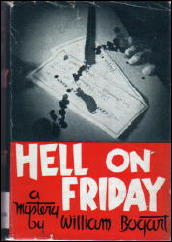
WILLIAM [G.] BOGART – Hell on Friday. Jonathan Swift, hardcover, 1941. Also published as Murder Man, Tech Mysteries, digest paperback, no date [1943?]
William G. Bogart was a prolific pulp writer in the Thirties and Forties. His chief claim to fame is that he ghosted a handful of the Doc Savage novels that have become so popular in paperback reprint. At his best, he was only a fair novelist; Hell on Friday is noteworthy primarily as one of only two mystery novels with a pulp publishing background. (The other is William P. McGivern’s But Death Runs Faster, published seven years later — a much better mystery novel but lacking the range of pulp lore and true pulpy feel of the Bogart book.)
Hell on Friday‘s protagonist, private eye Johnny Saxon, is a former “prince of the pulps” who quit writing after three years of phenomenal success because “the business had lost its kick for him [and] his stuff went stale.” His partner, Moe Martin, is “the loneliest literary agent in New York” — an emotional sponge who can lose himself in any narrative and therefore is incapable of telling the good from the bad.
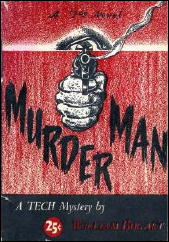
Saxon is hired by Joe Rogers, head of Rogers Publishing Company, a chain publisher of some twenty-two pulp magazines, to investigate the dubious business practices of a rival publisher, Sam Sontag.
Rogers also wants him to help persuade a love-pulpeteer who writes under the name Dulcey Dickens to sign an exclusive contract with his firm. Murder, the appearance of a racketeer named Jasper Ward, the disappearance of Dulcey Dickens, and other complications carry the narrative.
The plot isn’t particularly clever or exciting, and the solution holds no real surprises. Still, there is a certain charm to Hell on Friday (the title refers obliquely to the fact that Friday was payday for the legion of pulp writers, and often make-up day for the various magazines as well).
Saxon and Moe Martin are engaging characters (as is Dulcey Dickens), and the pulp setting is well drawn and packed with details fascinating to anyone with an interest in that vanished era. Saxon also stars in two other novels by Bogart — Murder Is Forgetful (1944) and The Queen City Murder Case (1946).
———
Reprinted with permission from 1001 Midnights, edited by Bill Pronzini & Marcia Muller and published by The Battered Silicon Dispatch Box, 2007. Copyright © 1986, 2007 by the Pronzini-Muller Family Trust.
Bibliographic Note: All three novels are available in an omnibus edition (Hell on Friday: the Johnny Saxon Trilogy) published by Altus Press, 2010).
Mon 3 Oct 2011
REVIEWED BY MICHAEL SHONK:
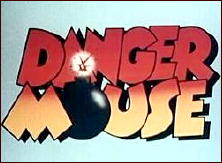
DANGER MOUSE. Animated. Episodes of five to twenty five minutes each. UK: 1981 through 1992. US: Nickelodeon premiered June 4, 1984. Cosgrove Hall Films. Thames Television. Created by Brian Cosgrove and Mark Hall. Voice Cast: Danger Mouse (David Jason), Penfold (Terry Scott), Colonel K (Edward Kelsey), Baron Silas Greenback (Edward Kelsey), Stiletto (Brian Trueman), Isambard Sinclair (David Jason), Nero (David Jason’s voice sped up). Available on DVD. Recommended: The shorter episodes on YouTube over the longer ones available on Hulu.com and IMDB.com.
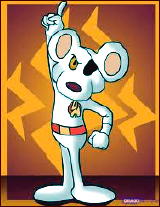
“He’s the greatest. – He’s fantastic. – Wherever there is danger he’ll be there. – He’s the Ace. – He’s amazing. – He’s the strongest, he’s the quickest, he’s the best! Danger Mouse…” (Theme sung by Sheila Gott.)
This action hero/spy comedy will appeal to all ages. The animation is limited, cheap, and guilty of reusing too much stock footage, but it also has a visually pleasing look and adds enough visual gags to be forgiven for its shortcomings.

The writing is top notch British silly, not unlike Monty Python. Parody and satire is common and not limited to the obvious targets of Bond and John Drake (Danger Man). Bad jokes and silly puns are there as well for the kid in all of us, though I guess children could watch this cartoon as well.
The character are well defined and funny. The narrator Isambard Sinclair introduces the story, explains things to the audience to keep the action moving, and occasionally asks questions at the end spoofing the narrators of old serials.
The good guys are lead by Danger Mouse. DM is a white mouse with an eye patch that goes well with his white jumpsuit that has DM monogrammed over his left breast. He is everything his theme song claims he is and more. His sidekick Penfold is a daft, but loyal hamster, codenamed “Jigsaw” because he always falls to pieces.

Colonel K is head of a secret organization and gives Danger Mouse his assignments. There is some question over what animal Colonel K is, a chinchilla or walrus (like it matters).
The villains are lead by DM’s archenemy Blofeld … oops, I mean … Baron Silas Greenback, the fiendish frog, the terrible toad, whose only wish is to take over the world or kill Danger Mouse so he can take over the world. Filling the role of insane villain’s pet is Nero a fluffy white caterpillar. Stiletto is a crow, an idiot, and the Baron’s top henchman.
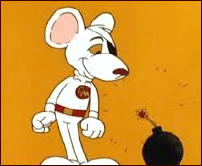
DM and Penfold live in a red pillar-box near Sherlock Holmes on Baker Street. As any proper spy of that era, Danger Mouse has a special car. The Mark III can do a variety of things including fly.
The plots the Baron creates to take over the world illustrates the series’ absurdist humor. In “Who Stole the Bagpipes?” bagpipes are sheep-like creatures grazing in Scotland. The Baron rustles ten thousand bagpipes to build a sonic weapon capable of destroying cities.
“Lord of the Bungle” has the Baron turning elephants into sugar cubes so when heads of state all over the world put the sugar cubes into their tea the elephant will reappear and squash the government leader.

My favorite is “The Dream Machine” when Danger Mouse and Pedfold are trapped in the Baron’s dream machine where surreal is reality, the impossible possible, and Penfold’s thoughts turn into visual puns.
If you are willing to overcome the misguided prejudice that cartoons are just for kids, give this a try. Or find some child to watch it with. Neither of you will regret it.
SOURCES:
Wikipedia
Cosgrove Hall Ate My Brain
DangerMouse.org
Tue 13 Sep 2011
THE CASES OF EDDIE DRAKE PART THREE:
THE PALEY CENTER JOINS THE FUN
by Michael Shonk
Before beginning, you may wish to go back to the first two in this series of articles about one of the more mysterious private eye series in early TV, The Cases of Eddie Drake. Part One is here, and Part Two followed soon thereafter.
After these two posts appeared, I asked various archives for information about the series. David Bushman of the Paley Center for Media Arts responded they had nine episodes and offered me the chance to watch them. To this old researcher it was like getting a free ticket to Disneyland, but I was unable to go. Mr. Bushman asked me to send in my questions and someone there would watch the episodes and try to find some answers.
I am amazed by the effort Mr. Bushman and the Paley Center put into answering questions about a show few remember and even fewer care about. If you have any interest in saving old television I can’t think of a better place to support or be a member. Please, check out their website at PaleyCenter.org.
The episodes were in no condition to view, so techs at the Paley Center have been hard at work making viewable digital copies. This done, Mr. Bushman watched the following episodes: “The Brass Key” (episode one), “Hush, Hush”, “Murder By Proxy”, “Murder in Three-Quarter Time”, “Sleep Well, Angel”, “The Judas Coin”, and “A Hole in the Head” (all with Patricia Morison). He also watched “Murder Ad Lib” and “The Man Who Was Nobody” (with Lynne Roberts).
With “Shooting The Works” (new link), this leaves only three episodes still missing.
While the question of when did Eddie Drake first air remains unknown, we have learned more about the series.
Copyright date on the Patricia Morison’s episodes is 1948. The copyright on the Lynne Roberts’ episodes is 1951. Copyright holder for both is IMPPRO. There is no mention on copyright screen of CBS, DuMont, or NBC.
“Were there any changes to the standing sets? Was Eddie’s rare 1948 Davis Divan in all episodes?” It is unlikely the sets for a series shelved for three years would have survived.
Eddie’s rare car was in all the episodes except the first “The Brass Key”. This makes “Shooting the Works” episode two since Eddie mentions he has bought a new car.
Amazingly, Mr. Bushman took the time out to map Eddie’s office in Morison and Roberts’ episodes. The water cooler, the map, the window with the fake brick wall showing through, the bookshelf, and the rest were the same. The most noticeable change was the set looks better in the Roberts’ episodes.
There were differences. The theme song and opening credits changed. Roberts’ episodes had a fancier title card featuring a full body silhouette of a man in a suit (drawing) in lower right corner of the screen his shadow cast under the letters of the title.
Morison’s episodes had her and Haggerty deliver the credits at the end, while Roberts’ episodes credits were graphics upfront.
“Any changes in the credits?” The chances the exact same people would return after three years is unbelievable.
The same people but with newly credited help. Jason James wrote all episodes seen, but the Roberts’ two had an additional credit for additional dialog by Robert Lehman. Harlan Thompson and Herbert Strock produced all episodes with Paul Garrison directing, Morison’s episodes had photography by Guy Roe OR Charles Trego. Roberts’ episodes had photography by Guy Roe and Lucien Androit. Strock was credited alone in the Morison’s episodes while he AND Ed Taylor got screen credit in the Roberts’ episodes. Assistant director was Leo Pepin then Leo Peppin (unknown why he added another p to his name) and Chuck Wasserman.
“Any differences in the two female characters?”
Both were psychiatrists. There is no mention of Dr. Gayle (Morison) or the book in the two Roberts’ episodes seen. The relationship between Drake and the two remains much the same. Cop Lt. Walsh is played by Theodore von Eltz in all episodes.
So what have we learned? For one, a major clue in the Producer credits.
Searching Billboard (at Google books), the August 13, 1949 issue, regarding the Ed Wynn Show for CBS, there was this: “Harlan Thompson named yesterday (6) as show’s associate producer. Thompson is a former veepee of IMPRRO (sic) Inc with film and Broadway musical comedy production experience.”
IMPPRO was still in production in 1952, but without Harlan Thompson. Herbert L. Strock was now President of the company.
If IMPPRO, the copyright holder, was still active, why would DuMont need to film the final four episodes? If DuMont did film the final four (as is currently believed), why were the thirteen episodes shown on WENR-TV starting September 7, 1951 when DuMont did not air Eddie Drake until March 6, 1952? If filmed in 1951, why is Harlan Thompson credited as producer when he left the company before August 1949?
Now what do we know and what can we deduce?
Billboard magazine from 1948 reported five episodes of Eddie Drake were delivered to CBS, with four more in editing. The filming of the final four episodes was scheduled for November 17, 1948.
Suddenly, Patricia Morison was offered the lead in Broadway play Kiss Me, Kate. She is gone. Deduction: This is why IMPPRO had to recast the part for the final four episodes to complete the order CBS had paid $300,000 for.
Current belief says CBS tossed the nine and never aired them. Why? $300,000 in 1948 is a great deal of money to just toss away. And why copyright the episodes in 1948?
If so many confirmed clues point to the final four being filmed in 1948-49, why are those episodes copyrighted 1951?
How the Sherlock Holmes do I know? But I can guess.
The improved look of the series probably came from a sudden increase in the budget. Where did IMPPRO get the money?
During the delay to recast, did CBS TV Film Sales copyright and shop the nine episodes around? Was the early sales of the first nine episodes where IMPPRO got the money to increase the budget?
But if the Roberts’ episodes were filmed in 1948-49, why weren’t they copyrighted then?
Deduction: something went wrong. Perhaps the sales were not good enough for CBS, so it didn’t bother to copyright the final four and shelved the entire series.
Until 1951 when there was a growing demand for TV Film syndicated series. CBS dusted off Cases of Eddie Drake, copyrighted the Roberts’ episodes, and sold them in syndication.
I remain convinced Eddie was on the air somewhere in 1949, but until I can prove it:
THE CASES OF EDDIE DRAKE (Syndicated) 1951. Created and written by Jason James. With additional dialog for few episodes by Robert Lehman. Produced by Harlan Thompson and Herbert L. Strock. Directed by Paul Garrison.
Tue 12 Jul 2011
Posted by Steve under
Reviews[6] Comments
THE BACKWARD REVIEWER
William F. Deeck
KEN CROSSEN – The Case of the Phantom Fingerprints. Vulcan Publications #5, digest-sized paperback original, 1945.
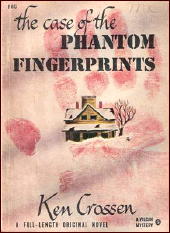
This is the second of two novels featuring the talents of Jason Jones, a very unusual detective first grade who is a fat, lazy, geranium-raising sleuth — the “poor man’s Nero Wolfe” — and the presence of, for he doesn’t seem to have any talent, Necessary Smith, private detective.
In this case, a straightforward murder is committed. Morris Block, Broadway producer and blackmailer, is stabbed to death at his home during a party. The murderer’s fingerprints are on the knife. When the police finish fingerprinting the group and discover a match, the killer vanishes from the house, despite all the doors being guarded by the police and the few unlocked windows having the snow on their sills undisturbed.
This is a fair-to-middling “impossible situation” novel. Those who have read Carter Dickson’s Nine–And Death Makes Ten will know how the murderer manages to disappear. One of the clues is a mystery novel, The Laughing Buddha Murders, another impossible-situation novel, by Richard Foster, one of Crossen’s pseudonyms, and published also by Vulcan.
— From The MYSTERY FANcier, Vol. 12, No. 3, Summer 1990.
Bibliographic Notes: The other, earlier case tackled by the detective duo of Jason Jones and Necessary Smith was The Case of the Curious Heel (Eerie Series, paperback, 1944).
If I am reading Bill correctly here, one of the clues in solving this mystery was another book by the same author but under a pen name. This can’t have happened often. (It is as if Sir Henry Merrivale referenced Gideon Fell in one of his locked room adventures.) Can anyone come up with another such instance?
Fri 1 Jul 2011
REVIEWED BY MICHAEL SHONK:

DEPARTMENT S. Syndicated in United States. ITC Production. 28 episodes. 60 minutes. 1969 through 1970. Created by Monty Berman and Dennis Spooner. Executive Story Consultant: Dennis Spooner. Produced by Monty Berman. Creative Consultant: Cyril Frankel. Musical Director: Edwin Astley. Cast: Peter Wyngarde (Jason King), Joel Fabiani (Stewart Sullivan), Rosemary Nicols (Annabelle Hurst), Dennis Alaba Peters (Curtis Seretse). Available on DVD but not in Region One format for the US.
In the 1960s the Beatles were not the only British to invade American pop culture. “Mod” fashions from London and the British TV and Film spies quickly followed. James Bond led the way, followed by The Avengers and a group of ITC-produced TV spies/detectives such as those in Department S. * (See FOOTNOTE.)
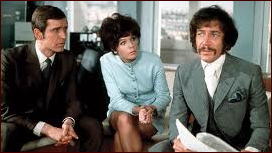
Department S was a small branch of Interpol made up of four people dedicated to solving the unsolvable crime. Or to quote a BBC2 introduction to the series (available on YouTube as “Department S: The Gen”), “If its too hot for the cops, a might complicated for the military, call Department S.”
Jason King was a flamboyant, best selling mystery writer who had a love for women and liquor. His fictional detective Mark Caine was in a series of books with such titles as Don’t Look Now But Your Clutch Is Slipping. King would often use Caine’s intuitive methods to help solve the mysteries facing Department S.
Jason King was played by Shakespearian actor, Peter Wyngarde, who Sir John Gielgud said was England’s most underrated actor. Wyngarde was a fan favorite, especially with women. The popularity of Wyngarde’s Jason King would lead to the character getting his own series in 1971.
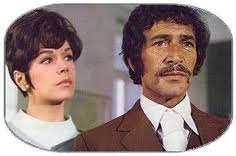
Stewart Sullivan was the team’s field leader. A man of action, his methods were more procedural such as questioning the suspects.
Annabel Hurst was the beautiful computer scientist whose beliefs in the scientific method of crime solving often put her in conflict with Jason’s more human deductions. Her clothes, what little she wore, were the latest in 1960s fashion.
Curtis Seretse was the bureaucrat in charge of Department S. According to the BFI website Screenonline, the use of a black actor for the part was “a bold piece of casting for its time.”
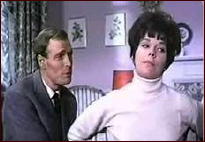
The four characters set up the ultimate conflict of mystery’s solving methods, with one method always successful in explaining the strangest twist.
Department S shared some characteristics with the more popular and famous The Avengers. Both featured the wild fashion of 60s London and highly stylized writing and direction. Most obviously, both series had a fondness for over the top bizarre plots.
In the first episode, “Six Days” (written by Gerald Kelsey and directed by Cyril Frankel), a commercial plane arrives at a London airport with all on board believing they are thirty minutes early, when they are really six days late. This episode can (for now) be seen on YouTube and is highly recommended. (The link will take you to Part 1 of 4.)
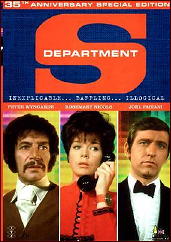
While still fun to watch, the cult favorite has its flaws. There were the typical television mystery annoyances such as a chase because no one thought to guard the exits. But the biggest problem for the modern viewer is what the viewers at the time enjoyed most, the now camp character of Jason King.
FOOTNOTE: The ITC series was made for the American television market, even using the American commercial format and length. It might have appeared in the U.S. first. This would explain why IMDb and BFI have different air dates for the series.
IMDb has the series lasting two seasons. Season One lasted eight episodes from March 9, 1969 through April 27, 1969. Season Two lasted twenty episodes from October 1, 1969 through March 24, 1970. BFI has the series lasting two seasons but starting September 3, 1969 and ending April 3, 1970.









